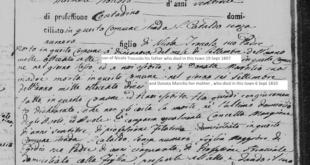Italian Telephone Phrases to Use with Friends
Once one is in Italy to visit relatives or friends, and especially for business, it is important to know both the familiar and polite Italian phrases used to initiate a telephone conversation.
When making a telephone call to a friend, two common greetings are used, depending on how well the friends know each other.
| Pronto. Sono Caterina. |
Ready. (for hello) I am Kathy. |
| Pronto. Sono io! |
Ready. (for hello) It’s me! (lit. It is I!) |
In some households in Italy, landlines are still in use. In this case, of course, one needs to be prepared to ask if a friend is at home and, if so, for the friend come to the phone. Also, it is possible to “drop by” unexpectedly or “fare un salto” to someone’s house and ask if a friend is home. Or, perhaps someone unexpected has answered a friend’s cell phone and you will have to request to speak to the person you originally called! In any of these situations, some common, informal phrases to use would be:
| Posso parlare con Paolo? | May I speak with Paul? |
| Paolo è a casa? | Is Paul at home? |
| C’è Paolo? | Is Paul there? |
If for some reason your friend is not available, you may receive one of the following replies below. The grammar for this simple act is somewhat complicated.
A few points:
First, Remember that c’è, from the verb esserci, means “here is.”
Also, as in the third example below, remember that ti (to him), becomes “te” when followed by a direct object pronoun such as “lo” for “him” and “la” for her.
Finally, the Italian and English sentence structures differ when using indirect and direct object pronouns. In Italian, all pronouns are usually placed before the verb, while in English they are placed after the verb. In this case, to speak like an Italian, we must “think in Italian!” As an aid in understanding these differences, in the examples below, the object pronouns have been underlined and the indirect object pronouns are in red.
| Si, aspetta un momento. | Yes, wait a moment. |
| Si, aspetta un attimo. | Yes, wait a second. (lit. moment) |
| Te lo/la passo. | I’ll put him/her through to you. |
| No, non è in casa. | No, (he/she) is not at home. |
| No, non c’è. | No, (he /she) is not here. |
If you want to try to get some information or leave a message, you might ask:
Quando torna? (lui/lei is usually omitted/understood from the conversation)
When (will) he/she return?
Sa quando torna? (lui/lei is usually omitted/understood from the conversation)
(Do) you know when he/she (will) return? (pol.)
If you’d like to make a request, such as for a call back or to leave a message, the following phrases listed below may be of use.
A few notes about the Italian grammar behind these common requests:
Notice that when asking someone to speak to another with the verb dire (to say/to tell), Italian uses indirect object pronouns. In other words, Italians tell information “to him” with gli and “to her” with le. (If you need a refresher about common Italian verbs that take indirect object pronouns, visit the previous blog in this series: “He Said/She Said… in Italian!).
When a helping verb (in this case può) is used before dire, the final “e” in dire is dropped and the indirect object pronoun is attached to “dir.” Also in the first sentence below, the Italian direct object pronoun “mi” has been added to the end of chiamare. The details for combining Italian helping verbs with infinitive verbs and object pronouns were discussed in our recent blog, “How to Use the Italian Verb Dovere.” The Italian indirect object pronouns are in red and the direct object pronouns have been underlined in the example phrases below.
The Italian grammar for these simple requests is complicated. You may want to simply memorize the sentences below, just in case you need to reach one friend or relation through another!
Può dirgli/dirle di chiamarmi?
Can you tell (to) him/her to call me? (pol.)
Può dirgli/dirle che ho chiamato?
Can you tell (to) him/her that I called? (pol.)
Può prendere un messaggio?
Can you take a message? (pol.)
Posso richiamare più tardi?
Can I call back later?
Richiamerei (un po’) più tardi.
I would like to call back (a little) later.
Richiamerò (un po’) più tardi.
I will call back (a little) later.
To end a telephone conversation with someone you know, if you want sound like a native Italian, try one of the following lines listed below. Of note, Italians often have difficulty ending a conversation — both in person and on the telephone! But, for some reason, the expression “Ciao ciao!” means the conversation is really over or “è chiuso” (is closed) as an Italian would say. In general, after one of the parties says “Ciao ciao!” no further comments will be heard!
| Ci sentiamo… | We will speak to each other… (lit. hear each other) |
| …a più tardi /dopo / presto. | …later / later / soon. |
| Devo scappare! | I must run! (lit. escape/run away) |
| Richiamami! | Call me back! (fam. command) |
| Chiamami! | Call me! (fam. command) |
| Fatti sentire! | Let me hear from you! (lit. Make yourself heard!) |
| Ciao! | Bye! |
| Ciao ciao! | Bye bye! |
Italian Telephone Phrases to Use with Business Associates
A receptionist at a business may answer the phone with “Pronto!” followed by one of the following questions:
| Pronto. Che cosa posso fare per Lei? |
Hello. What can I do for you? (pol.) |
| Posso aiutarla? | May I help you? (pol.) |
| Chi parla? | Who is speaking? (pol.) |
| Chi chiama? | Who is calling? (pol.) |
Replies to the receptionist at a business office might include the lines below. Notice that the polite “io” conditional form of volere, which is “vorrei” is used to make the initial request after the perfunctory “Pronto.” The polite “you” present tense of potere, which is “può,” is also important to know in this situation. Do you remember how useful both vorrei and può are for travelers from our previous blogs? To learn about a method to ask for what you need in Italy using vorrei and può, visit the blogs “Being Polite with Volere” and “Being Polite with Volere.”
Also notice the Italian use of a definite article (il, la) before Mr., Mrs., or Miss during introductions from the first two examples below.
Pronto. Sono il signor / la signora / la signorina Rossi.
Hello. I am Mr. / Mrs. / Miss Rossi.
Vorrei parlare con il signor Manzini.
I would like to speak with Mr. Manzini.
Mi può passare il direttore, per piacere?
Can you put me through to (give me) the director, please? (pol.)
Me lo può passare?
Can you put him through to me? (pol.)
Me la può passare?
Can you put him through to me? (pol.)
If speaking to a colleague, or someone you know well at a business, the polite conditional vorrei for “I would like” is still considered an educated way to make the first request. However, the familiar “you” of potere, which is puoi, is permitted as the conversation continues.
Mi puoi passare il direttore, per piacere?
Can you put me through to (give me) the director, please? (familiar)
Me lo puoi passare?
Can you put him through to me? (familiar)
Me la puoi passare?
Can you put him through to me? (familiar)
After requesting to speak to a business associate, you may hear the following replies below. Notice the use of indirect object pronouns again in the last example (given in red). In this case, when combining gli with either lo or la, one must follow the Italian grammar rule to insert an “e” between the indirect and direct object pronouns. This will also give a subtle change to the pronunciation of “gli,” which is now pronounced, “glie” as part of the newly created words, “glielo” or “gliela.”
Once again, the Italian grammar for these simple lines is complicated. You may want to simply memorize the sentences below, as they are likely to come up frequently if you decide to stay in Italy for a bit!
Resti in linea, per favore.
Hold (the line), please. (pol. command)
Mi dispiace, ma…
I’m sorry, but…
…il direttore è occupato.
…the director is busy.
…il direttore non c’è oggi.
…the director is not in today.
…il direttore è (appena) uscito(a).
…the director has (just) stepped out. (masc./fem.)
…il direttore è in riunione.
…the director is (attending) in a meeting.
Glielo passo. / Gliela passo.
I’ll put him/her through to you. (pol.)
Voicemail Messages
When communicating with both friends and business associates, it may also be necessary to decode a voicemail recorded in Italian or to leave a message in Italian with the particulars needed for a return call.
Italian phrases you may hear on voice mail:
La segreteria telefonica di…
The voice mailbox/answering machine of…
Non posso/possiamo rispondere al telefono ora.
I/We cannot answer the phone now.
Lasciate il vostro messaggio, e il vostro nome, la data, e l’ora della vostra chiamata…
Leave your message, and your name, the date, and the time of your call…
…e il vostro numero di telefono
…and your telephone number
…dopo il segnale acustico.
…after the beep.
Vi richiamerò/Vi richiameremo presto.
I/We will call you all back soon.
How to leave a voicemail message in Italian.
First, identify yourself and leave a short message about why you are calling. First, identify yourself and leave a short message about why you are calling. Remember to use the Italian definite article before your last name if leaving a formal message!
Sono la signora Manzini.
I am Mrs. Manzini.
Sono Caterina.
I am Kathy.
Vorrei parlare di…
I want to talk about…
Possiamo parlare di…
Can we talk about…
Then, state the date and time of your call.
Oggi è lunedì tre agosto, alle 10 di mattina. (American way of thinking)
Today is Monday, August third, at 10 AM.
-or-
Oggi sono le 10 di mattina di lunedì tre agosto. (What an Italian would say.)
Today it is 10 AM on Monday, August 3.
Finally, leave your telephone number or email.
Il mio numero di telefono è…
My telephone number is…
La mia mail è…
orders chiocciola Stella Lucente punto com.
My email is… orders@stellalucente.com.
Remember familiar and polite
Italian Phrases for Telephone Conversations
and I guarantee you will use these phrases every day!
For “All the Italian you need to enjoy your trip to Italy,” click on the links below to purchase my Conversational Italian for Travelers books – and then listen to the audiobook “Just the Important Phrases” on your favorite streaming platform! -Kathryn Occhipinti


 Fra Noi Embrace Your Inner Italian
Fra Noi Embrace Your Inner Italian






